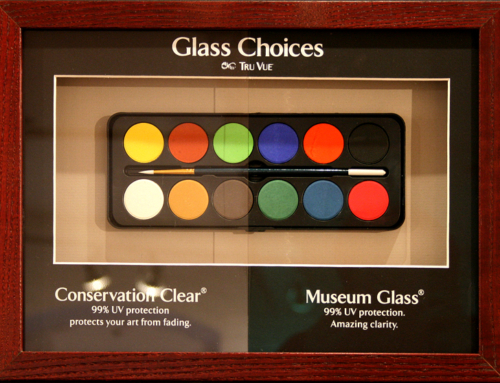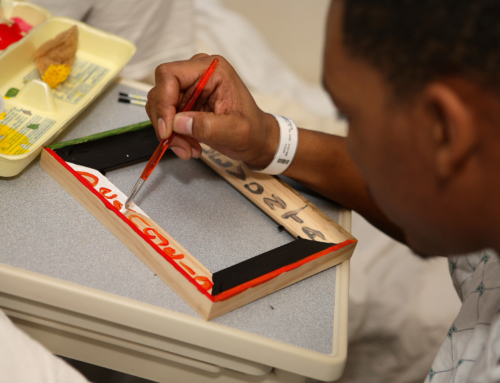Now that the healing qualities of art have been documented by solid research from Great Britain, Scandinavia and other countries, progressive hospitals nationwide are seeking the advice of professionals to select and provide appropriate artwork.
As new evidence has emerged that artwork has a measurably positive effect on Alzheimer’s and dementia patients, nursing homes, in particular, are moving to adopt artwork specifically chosen to address their residents’ illnesses.
Selecting the perfect artwork for nursing homes requires following very specific guidelines, according to healthcare art consultant Jan Marion, certified picture framer and owner of H. Marion Framing Studio, Inc. in Chicago’s north suburban area.
In recent years, Marion has become one of the Chicago area’s most sought-after experts in healing art, providing limited-edition, poster-quality and fine art for prominent hospitals and medical centers including Holy Family Nursing and Rehabilitation Center, Loyola University Health System, the Resurrection Health Care Group, Saint Mary of Nazareth Hospital Center, Saint Francis Hospital, Northwestern Memorial and West Suburban Medical Center.
“Elderly residents in the nursing home environment are very much in need of stimulation, and giving them art imagery to spark their imagination is one way to accomplish that,” says Marion, whose whose H. Marion Framing Studio has been in business for 33 years.
He notes, “At Holy Family Nursing and Rehabilitation Center, there are floors to serve the needs of the general population and separate areas for Alzheimer’s and dementia residents. But providing stimulation through imagery is the common thread that runs through the entire facility.”
Marion cautions that there’s such a thing as too much stimulation when it comes to nursing home residents. “Overly impressionistic or jumpy images are difficult for the elderly viewer to look at,” he says. “Nursing home residents benefit most from comfort imagery – scenes of daily life with homes, children and animals.”
Raphael DeOcampo, Director of Dementia and Special Care at Holy Family Nursing and Rehabilitation Center agrees with the value of comfort imagery, noting, “Our residents are especially fond of a certain picture in which an old man and a young boy – presumably, a grandfather and grandson – are sitting together on a bench.
The staffers will take a resident over to the picture, point at it and say, “What do you see in this? What do you remember?’ The resident will answer, ‘I remember being with my grandfather.'”
It’s not surprising, then, that today’s senior residents in nursing homes react very positively to the homey, nostalgic illustrations of Norman Rockwell.
According to Marion, “Rockwell fills several niches: his work is comforting, it shows people engaged in activities, and is reminiscent of the old days. The staff will use his images as springboards for conversation with residents. ‘Look at that,’ they’ll say. ‘Remember when you had a dog?'”
Marion notes that grouping similar images in a single room can help Alzheimer’s patients with the process of “way-finding.” “On Holy Family’s Alzheimer’s floor, one room is filled with Rockwell’s,” he says.
“Another room features very vivid nature photography, while still another is all vintage posters of train lines, of bygone Chicago, etc. This way, the residents can orient themselves more easily: ‘Oh, this is the Rockwell room.’
“Alzheimer’s patients are often disoriented, confused and scared, and that’s why we select comfort imagery,” Marion continues. “Nothing edgy, nothing provocative: no nudes, no imagery depicting, say poverty – only positive images. At Holy Family, another of the residents’ favorite images is a child on horseback, carrying flowers. It’s got everything going for it: a sweet, young person and an animal, embarking on a loving activity, with a beautiful natural backdrop.”
Subject matter is not the only consideration of primary importance to nursing home art selection, according to Marion. Color plays a major role as well.
“Many older individuals have vision problems, resulting from cataracts and strokes,” he says. “Or they may have sclerosis of the lens, resulting in a yellowish field of vision. It makes viewing blues and greens difficult, to the less blues and greens, the better. High-contrast images in colors like orange, red and white are much easier for older patients to see.”
Another visual issue to consider when installing nursing home art is glare. “It’s usually just a distraction to you and me,” says Marion, “but for the elderly, it’s a big problem.
“For that reason, we tend to use non-glare glass in nursing homes. This may affect the optical clarity of the print, but brighter, more high-contrast images can compensate for that slight loss of clarity.”
“Art matters in a nursing home,” says Marion, “because it makes the facility feel like home. Art is often the last item to be budgeted in a facility, but it’s the first thing patients react to,” he points out.
“Just as they do when entering a house, they’ll notice a beautiful piece of art before they’ll notice the carpeting or the hardware on the doors.
“Artwork is a vital interior design element that not only adorns a house – it makes the house a home. That same philosophy needs to be extended to nursing homes.”







